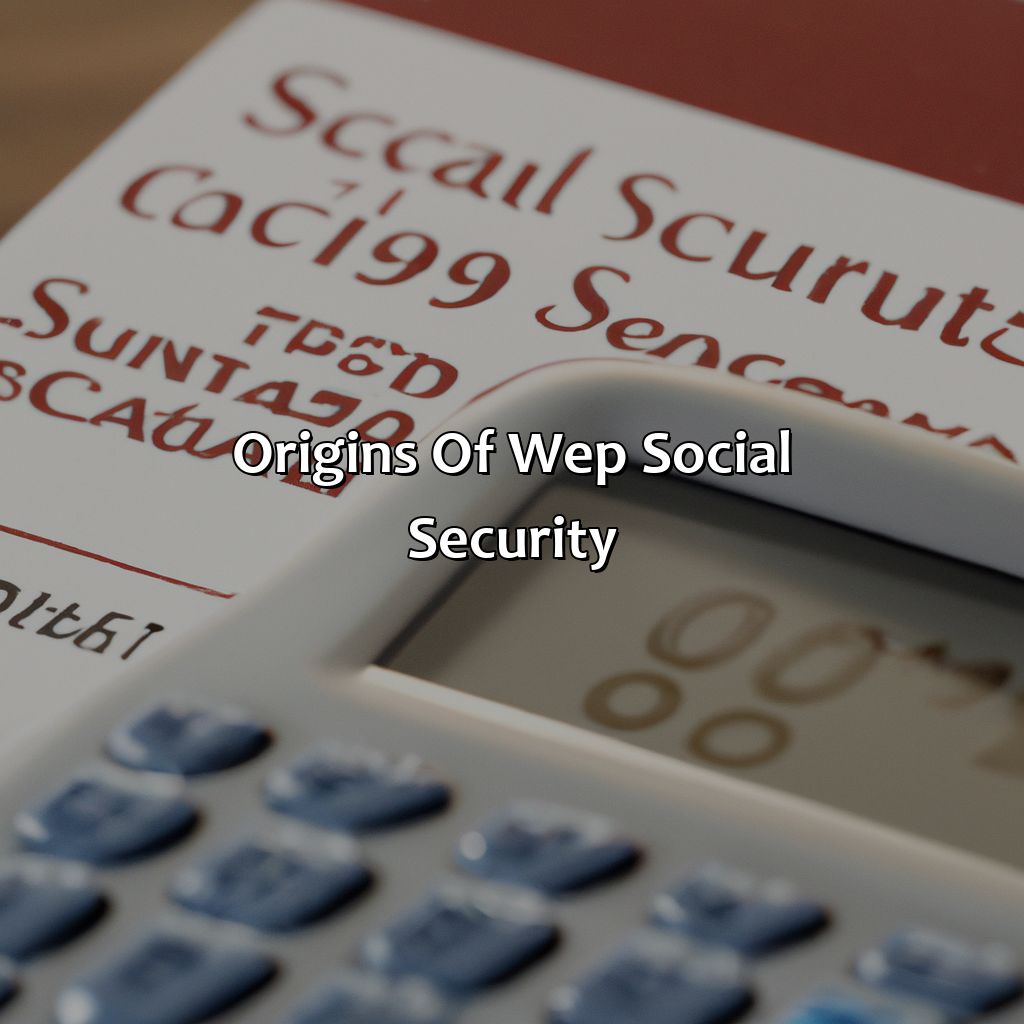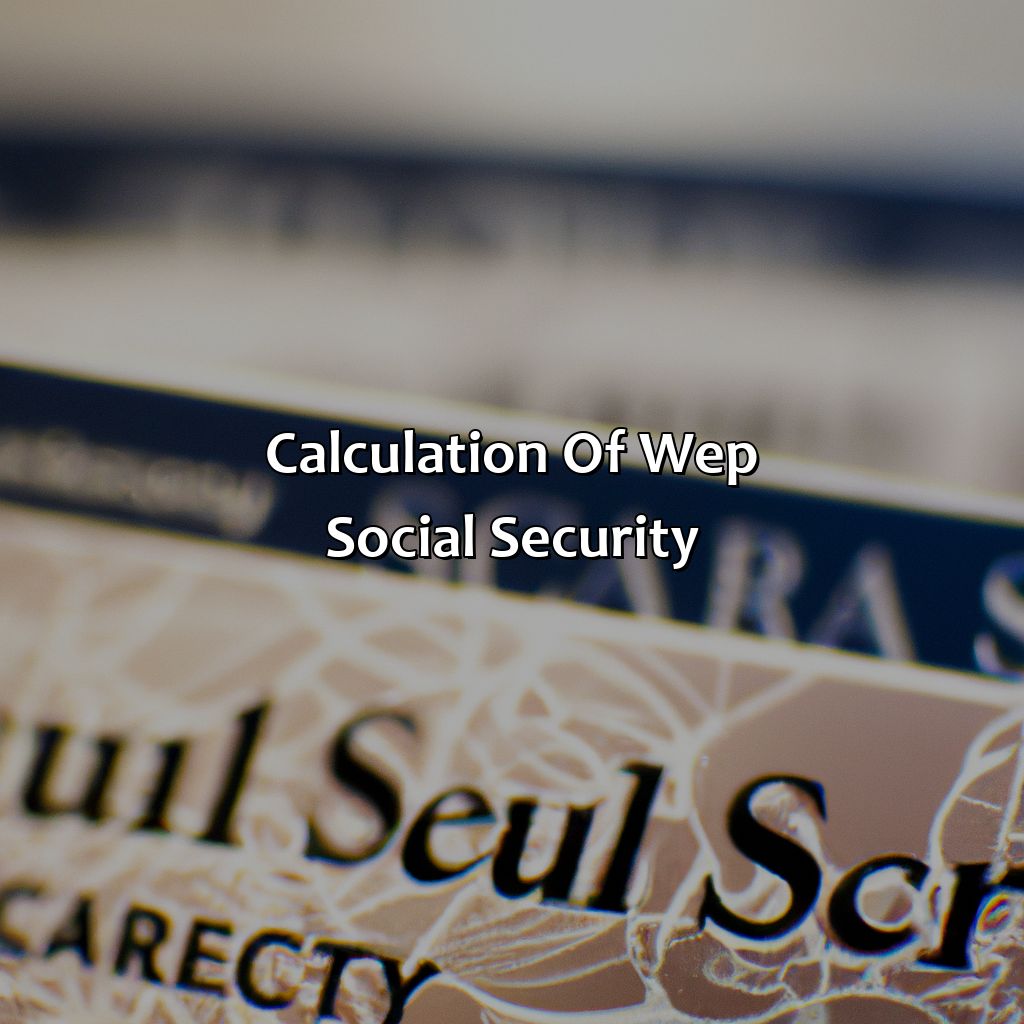What Is Wep Social Security?
Key Takeaway:
- WEP Social Security is a government program that affects people who receive a pension from a job not covered by Social Security and also worked in other jobs that were covered by Social Security.
- The program was introduced in 1983 to address concerns about the fairness of the Social Security system and ensure equitable benefits for all citizens.
- Those who are affected by WEP Social Security may have their Social Security benefits reduced, but there are ways to find out if you are eligible for WEP and how to minimize the impact.
Are you feeling overwhelmed with Social Security rules and regulations? Worry not! In this article, we’ll explain exactly what WEP Social Security is and how it affects you. You’ll gain a better understanding of this important program and how it may affect your retirement planning.
What is WEP Social Security?
WEP Social Security refers to the Windfall Elimination Provision, which reduces the Social Security benefits of employees who receive pensions from jobs not covered by Social Security. The formula for calculating benefits is adjusted, taking into account the pensions earned outside of Social Security. This provision aims to prevent overcompensation by the system and to ensure fair retirement benefits. It affects those who have worked both in Social Security-covered employment and non-covered employment. It is important to note that government pensions from work not covered by Social Security, such as those in state and local government, may trigger WEP.
An individual’s Social Security benefits may vary depending on their work history and the pensions earned outside of Social Security. The amount of reduction in benefits depends on the years worked outside of Social Security and the wages earned. It is essential to plan ahead and understand the impact of pensions earned outside of Social Security on retirement benefits. Those affected may consult the Social Security Administration or a financial advisor for guidance on planning retirement income.
It is important to note that a pension from work not covered by Social Security can affect not only an individual’s Social Security benefit but also their spouse’s or dependents’ benefits. This reduction can cause individuals to experience financial hardship during retirement.
According to a report by the Social Security Administration, as of April 2021, approximately 1.9 million Social Security beneficiaries were subject to WEP. It is crucial to understand the implications of WEP to avoid unexpected reductions in retirement benefits.

Image credits: retiregenz.com by Harry Duncun
Origins of WEP Social Security
WEP Social Security: A Brief History
WEP Social Security is a social security benefit formula used in the United States. It was implemented in 1983 to prevent individuals who worked in both Social Security-covered and non-covered employment from having an unfair advantage. Essentially, the WEP formula uses a modified calculation method to determine the amount of Social Security benefits an individual is entitled to.
The origins of WEP Social Security can be traced back to the Social Security Amendments of 1983. The legislation aimed to improve the long-term financial stability of the Social Security system. As part of its provisions, it introduced the Windfall Elimination Provision (WEP), which changed the way Social Security benefits were calculated for individuals who worked in jobs not covered by Social Security.
Under the WEP formula, an individual’s Social Security retirement or disability benefit is reduced based on the number of years they worked in a job that did not pay into the Social Security system. The reduction is designed to offset the advantage gained by individuals who receive a pension from such non-covered employment.
While the WEP formula has been criticized for being overly complex, it remains an important factor in determining Social Security benefits for millions of Americans. According to the Social Security Administration, there were over 2.2 million beneficiaries affected by the WEP provision in 2021.
Fun Fact: The WEP provision was named after Congressmen Eldon Rudd and Daniel Evans, the original sponsors of the bill that introduced the provision.

Image credits: retiregenz.com by David Washington
Who is affected by WEP Social Security?
WEP Social Security affects individuals who receive pensions from work not covered by Social Security. These individuals could be teachers, firefighters, or police officers. Their Social Security benefits are reduced by WEP to account for their pensions.
The reduction is based on a formula which considers the years of non-covered work and the individual’s average indexed monthly earnings. The more years of non-covered work, the higher the reduction is.
It’s important to note that not all individuals with pensions from non-covered work will be affected by WEP Social Security. Those who receive a small portion of their income from non-covered work may not see a significant reduction in their benefits.
Pro tip: It’s important to plan ahead and understand how WEP Social Security may impact your retirement income. Consult with a financial advisor to discuss your options.

Image credits: retiregenz.com by Harry Arnold
How WEP Social Security works
WEP Social Security is a set of rules that can impact the retirement benefits of those who receive both Social Security and a pension from non-covered work. The calculation of the Social Security benefit is adjusted based on a formula to ensure fairness for all retirees. This formula takes into consideration the amount of earnings and duration of contributions made to the Social Security system.
WEP Social Security works by reducing the Social Security benefit for individuals who receive a pension from non-covered work, as it is assumed that they have already benefited from a retirement plan. This reduction is based on a formula, which calculates the Windfall Elimination Provision (WEP) adjustment, that considers the number of years of substantial earnings that were not subject to Social Security taxes.
It is important to note that the WEP Social Security formula only impacts those who have worked in jobs that are not covered by Social Security but have earned a pension. The WEP Social Security adjustment creates a compromise to ensure that those who have paid into both Social Security and a non-covered work pension receive a fair Social Security benefit.
Many people were unaware of the WEP Social Security formula and were surprised when their benefits were adjusted. The WEP Social Security adjustment has faced criticism from many individuals who feel that it is unfair. However, it is important to understand that the WEP Social Security adjustment ensures that Social Security remains sustainable for all future retirees. It is a necessary compromise to ensure that everyone receives a fair retirement benefit from Social Security.

Image credits: retiregenz.com by Joel Duncun
Calculation of WEP Social Security
The WEP Social Security calculation determines the amount of benefits a person is entitled to receive based on their earnings history. A formula is used to adjust benefits for those who have received pensions from jobs that were not covered by Social Security.
| Year of eligibility | Primary Insurance Amount (PIA) | WEP Reduction | Adjusted PIA |
|---|---|---|---|
| 2019 | $1,471 | $525 | $946 |
| 2018 | $1,422 | $463 | $959 |
| 2017 | $1,360 | $413 | $947 |
It’s important to note that the unique details of the WEP calculation vary based on individual circumstances, such as the number of years worked in non-Social Security jobs and the amount of the pension received.
To minimize the impact of WEP on Social Security benefits, individuals can consider delaying their retirement to increase their PIA or working longer in jobs that are covered by Social Security. It’s also important to report all earnings to ensure accurate benefit calculations.

Image credits: retiregenz.com by David Duncun
How to find out if you are eligible for WEP Social Security
Eligibility for WEP Social Security can be determined by checking the Social Security Statement. This document details the person’s earnings history and provides an estimate of benefits. Look for the Windfall Elimination Provision (WEP) on the statement, which can impact the amount of the benefit. To receive a pension from a job that did not pay into Social Security, one must have worked long enough to qualify for both the pension and Social Security benefits. This can be checked by reviewing the earnings history and the required credits for eligibility.
Pro Tip: Consult with a financial advisor to determine the best retirement strategy based on individual circumstances.

Image credits: retiregenz.com by Harry Arnold
How to apply for WEP Social Security
To obtain benefits from WEP Social Security, it is crucial to understand the application procedure. This guide explains the steps for a successful application.
- Collect necessary documents like your social security number.
- Evaluate eligibility criteria to ensure you can apply.
- Create an online account on the Social Security Administration website.
- Apply for benefits by filling out an application online or via phone.
- Submit required documents to the Social Security Administration.
- Wait for a response from the agency regarding your application status.
It’s essential to note that WEP Social Security benefits are different from regular Social Security benefits. The amount you receive under WEP Social Security may be less, as it takes into account work done in positions not covered under Social Security.
To increase your chances of receiving full benefits, ensure that you submit all necessary documentation, like your work history and other relevant information. Additionally, consider speaking to a representative from the Social Security Administration if you have any questions or need any guidance during the application process. Remember, applying early can also help ensure you receive the full benefits you deserve.

Image credits: retiregenz.com by Adam Arnold
Some Facts About What Is WEP Social Security:
WEP (Windfall Elimination Provision) is a social security rule that affects certain retirees who receive pensions from non-covered employment. (Source: Social Security Administration)
WEP can reduce the amount of a retiree’s social security benefits by up to two-thirds of their pension amount. (Source: Investopedia)
The purpose of WEP is to prevent “windfall” benefits for retirees who receive both a pension from non-covered employment and social security benefits. (Source: The Balance)
Not all retirees are affected by WEP, only those who have worked in jobs not covered by social security and earned a pension from those jobs. (Source: AARP)
WEP does not affect spousal or survivor benefits. (Source: Social Security Timing)
FAQs about What Is Wep Social Security?
What is WEP Social Security?
WEP Social Security is a special calculation method used by the Social Security Administration for individuals who receive a pension from non-covered work, such as working for a government agency or a foreign employer, and are also eligible for Social Security benefits based on their earnings from covered work. It is commonly referred to as the Windfall Elimination Provision.
Who is affected by WEP Social Security?
WEP Social Security typically affects individuals who worked in a job where they did not pay Social Security taxes, such as many state and local government workers, as well as those who worked for foreign employers. If these individuals also have worked in a job where they paid Social Security taxes long enough to qualify for retirement benefits, their Social Security benefits may be reduced under the WEP formula.
How is WEP Social Security calculated?
WEP Social Security is calculated using a formula that takes into account both the individual’s earnings from covered work and their pension from non-covered work. The WEP formula applies a lower percentage to each dollar of average indexed monthly earnings than the regular Social Security formula, resulting in a lower benefit amount.
Can I do anything to prevent my Social Security benefits from being reduced by WEP?
There are a few strategies that may help reduce the impact of WEP Social Security, such as delaying Social Security benefits, working in a job that pays Social Security taxes for a longer period of time, or reducing the impact of your pension from non-covered work.
What should I do if I think I am affected by WEP Social Security?
If you think you may be affected by WEP Social Security, you should contact the Social Security Administration to request a WEP calculation. You may also want to speak with a financial planner or Social Security specialist to determine the best strategies to maximize your retirement income.
Will WEP Social Security affect my spouse’s Social Security benefits?
WEP Social Security only affects the individual’s own retirement benefits, not their spouse’s benefits. However, if the individual receives a spousal benefit based on their spouse’s earnings record, that benefit may be reduced if the individual’s own retirement benefit is reduced by WEP.
 Checkout this IRS Loophole
Checkout this IRS Loophole 
